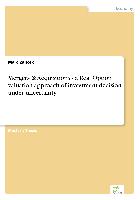- Start
- Mergers & Acquisitions - a Real Option valuation approach of investment decision under uncertainty
Mergers & Acquisitions - a Real Option valuation approach of investment decision under uncertainty
Angebote / Angebote:
Inhaltsangabe:Abstract:
The objective of this dissertation is to examine the application of Real Options for the evaluation of companies with regard to acquisitions. There has been an intensive scientific discussion in the past years about the Real Options method for the evaluation of investments and mergers & acquisitions as in practice usually the management tries to capture future developments with static methods of capital budgeting. For example, future cash-flows are discounted with a fixed risk-adjusted discount rate. Therefore, the Real Options approach has been applied very rarely as it has the reputation of high complexity and poor practicability in daily business. However, the use of present values and capitalized values may produce pitfalls in acquisition decisions as strategic investment decisions might be characterized by a wide range of possibilities to react flexibly to a fast changing environment.
In chapter 1, the term Mergers & Acquisitions (M&A, ) is defined and the motives as well as the relevance of M&A, transactions for different branches are described in detail. Furthermore, the process and the different phases of a merger or an acquisition are explained.
Chapter 2 presents traditional evaluation methods of static net present value, sensitivity analysis, Monte Carlo and decision tree. These classic methods are discussed and a comparison is drawn among these techniques in regard to practicability. At the end of this chapter, a evaluation is presented in regard to specific situations with the mayor parameter of uncertainty and flexibility for the application of these classic methods.
The basic concept of option pricing is described in chapter 3. In addition, the Black-Scholes equation and the underlying assumptions are explained in detail in order to understand financial options, which are the basic for the Real Options approach. At the end of the chapter, an example of a call and put option is discussed in order to understand the functioning of options.
Chapter 4 presents an introduction and definition of the Real Options method. Furthermore, the value drivers and the value creation due to the application of Real Options are discussed and analyzed in detail. After the discussion of the functioning of Real Options, a comparison of the analogy between financial Options and Real Options is done in order to possible differences. In this context, the limitations of the analogy of financial and Real Options are presented. Finally, [...]
Folgt in ca. 10 Arbeitstagen
